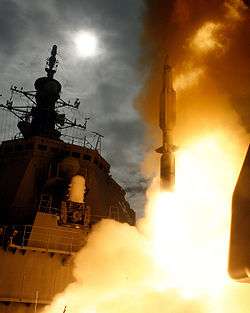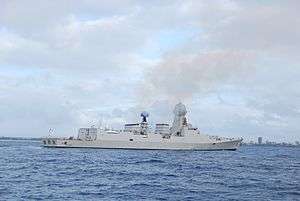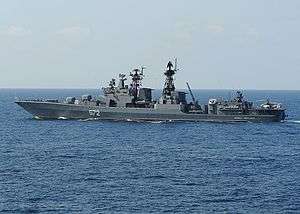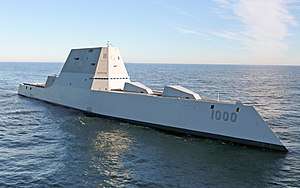Guided-missile destroyer
A guided-missile destroyer is designed to launch anti-aircraft guided missiles. Many are also equipped to carry out anti-submarine, anti-air, and anti-surface operations. The NATO standard designation for these vessels is DDG. Nations vary in their use of destroyer D designation in their hull pennant numbering, either prefixing or dropping it altogether. The U.S. Navy has adopted the classification DDG in the American hull classification system.

In addition to the guns, a guided-missile destroyer is usually equipped with two large missile magazines, usually in vertical-launch cells. Some guided-missile destroyers contain powerful radar systems, such as the United States’ Aegis Combat System, and may be adopted for use in an anti-missile or ballistic-missile defense role. This is especially true for navies that no longer operate cruisers, so other vessels must be adopted to fill in the gap.
Active and planned guided-missile destroyers
Royal Australian Navy
- Hobart-class destroyer
- HMAS Hobart (DDG-39)
- HMAS Brisbane (DDG-41)
- HMAS Sydney (DDG-42)
Chinese People's Liberation Army Navy
- Type 055 (Renhai class) destroyer
- Nanchang (DDG-101)
- Innominate 2nd ship (Fitting out)
- Innominate 3rd ship (Fitting out)
- Innominate 4th ship (Fitting out)
- Innominate 5th ship (Under construction)
- Innominate 6th ship (Under construction)
- Innominate 7th ship (Under construction)
- Innominate 8th ship (Under construction)
- Type 052D (Luyang III class) destroyer
- Kunming (DDG-172)
- Changsha (DDG-173)
- Hefei (DDG-174)
- Yinchuan (DDG-175)
- Xining (DDG-117)
- Xiamen (DDG-154)
- Urumqi (DDG-118)
- Nanjing (DDG-155)
- Guiyang (DDG-119)
- Hohhot (DDG-161)
- Taiyuan (DDG-131)
- Chengdu (DDG-120) (Sea trial)
- Qiqihar (DDG-121) (Sea trial)
- Zibo (DDG-132) (Fitting out)
- Ganzhou (DDG-162) (Fitting out)
- Huainan (Fitting out)
- Nanning (Fitting out)
- Baotou (Fitting out)
- Tangshan (Fitting out)
- Suzhou (Fitting out)
- Innominate 21st ship (Under construction)
- Innominate 22nd ship (Under construction)
- Innominate 23rd ship (Under construction)
- Innominate 24th ship (Under construction)
- Innominate 25th ship (Contract awarded)
- Innominate 26th ship (Contract awarded)
- Type 052C (Luyang II class) destroyer
- Lanzhou (DDG-170)
- Haikou (DDG-171)
- Changchun (DDG-150)
- Zhengzhou (DDG-151)
- Jinan (DDG-152)
- Xi'an (DDG-153)
- Type 052B (Luyang I class) destroyer
- Guangzhou (DDG-168)
- Wuhan (DDG-169)
- Type 051C (Luzhou class) destroyer
- Shenyang (DDG-115)
- Shijiazhuang (DDG-116)
- Type 051B (Luhai class) destroyer
- Shenzhen (DD-167)
- Sovremenny-class destroyer
- Hangzhou (DDG-136)
- Fuzhou (DDG-137)
- Taizhou (DDG-138)
- Ningbo (DDG-139)
French Navy
Although the French Navy no longer uses the term "destroyer", the largest frigates are assigned pennant numbers with flag superior "D", which designates destroyer.
Indian Navy
- Visakhapatnam-class destroyer
- INS Visakhapatnam (D66) (Fitting out)[1]
- INS Mormugao (D67) (Fitting out)[2]
- INS Imphal (D68) (Fitting out)
- INS Porbandar (D69) (Under construction)

- Kolkata-class destroyer
- INS Kolkata
- INS Kochi
- INS Chennai
- Delhi-class destroyer
- INS Delhi
- INS Mysore
- INS Mumbai
- Rajput-class destroyer
- INS Rajput
- INS Rana
- INS Ranvir
- INS Ranvijay
Italian Navy
- Durand de la Penne-class destroyer
- Luigi Durand De La Penne (D 560)
- Francesco Mimbelli (D 561)
Japan Maritime Self-Defense Force
- Maya-class destroyer
- Atago-class destroyer
- JS Atago (DDG-177)
- JS Ashigara (DDG-178)
- Kongō-class destroyer
- JS Kongo (DDG-173)
- JS Kirishima (DDG-174)
- JS Myoko (DDG-175)
- JS Chokai (DDG-176)
- Hatakaze-class destroyer
- JS Hatakaze (DDG-171)
- JS Shimakaze (DDG-172)
Republic of Korea Navy
- Sejong the Great-class destroyer
- ROKS Sejong the Great (DDG-991)
- ROKS Yulgok Yi I (DDG-992)
- ROKS Seoae Yu Seong-ryong (DDG-993)
- Chungmugong Yi Sun-sin-class destroyer
- ROKS Chungmugong Yi Sun-sin (975)
- ROKS Munmu the Great (976)
- ROKS Dae Jo-yeong (977)
- ROKS Wang Geon (978)
- ROKS Gang Gam-chan (979)
- ROKS Choe Yeong (981)
Russian Navy
_is_currently_underway_participating_in_Baltic_Operations_(BALTOPS)_2005.jpg)

- Kashin-class destroyer
- Smetlivy (810)
- Sovremenny-class destroyer
- Bystryy (715)
- Gremyashchiy (406)
- Bespokoynyy (620)
- Nastoychivyy (610)
- Admiral Ushakov (434)
- Udaloy-class destroyer
- Vice-Admiral Kulakov
- Admiral Tributs (552)
- Marshal Shaposhnikov (543)
- Severomorsk (619)
- Admiral Levchenko (605)
- Admiral Vinogradov (572)
- Admiral Panteleyev (548)
- Admiral Chabanenko (650)
Republic of China Navy
.jpg)
- Kee Lung-class destroyer (ex-Kidd class)
- ROCS Kee Lung (DDG-1801)
- ROCS Su Ao (DDG-1802)
- ROCS Tso Ying (DDG-1803)
- ROCS Ma Kong (DDG-1805)
Royal Navy
- Type 82 destroyer
- HMS Bristol (D23) (now as training hulk, without missiles)
- Type 45 destroyer
United States Navy

- Arleigh Burke-class destroyer
- USS Arleigh Burke (DDG-51)
- USS Barry (DDG-52)
- USS John Paul Jones (DDG-53)
- USS Curtis Wilbur (DDG-54)
- USS Stout (DDG-55)
- USS John S. McCain (DDG-56)
- USS Mitscher (DDG-57)
- USS Laboon (DDG-58)
- USS Russell (DDG-59)
- USS Paul Hamilton (DDG-60)
- USS Ramage (DDG-61)
- USS Fitzgerald (DDG-62)
- USS Stethem (DDG-63)
- USS Carney (DDG-64)
- USS Benfold (DDG-65)
- USS Gonzalez (DDG-66)
- USS Cole (DDG-67)
- USS The Sullivans (DDG-68)
- USS Milius (DDG-69)
- USS Hopper (DDG-70)
- USS Ross (DDG-71)
- USS Mahan (DDG-72)
- USS Decatur (DDG-73)
- USS McFaul (DDG-74)
- USS Donald Cook (DDG-75)
- USS Higgins (DDG-76)
- USS O'Kane (DDG-77)
- USS Porter (DDG-78)
- USS Oscar Austin (DDG-79)
- USS Roosevelt (DDG-80)
- USS Winston S. Churchill (DDG-81)
- USS Lassen (DDG-82)
- USS Howard (DDG-83)
- USS Bulkeley (DDG-84)
- USS McCampbell (DDG-85)
- USS Shoup (DDG-86)
- USS Mason (DDG-87)
- USS Preble (DDG-88)
- USS Mustin (DDG-89)
- USS Chafee (DDG-90)
- USS Pinckney (DDG-91)
- USS Momsen (DDG-92)
- USS Chung-Hoon (DDG-93)
- USS Nitze (DDG-94)
- USS James E. Williams (DDG-95)
- USS Bainbridge (DDG-96)
- USS Halsey (DDG-97)
- USS Forrest Sherman (DDG-98)
- USS Farragut (DDG-99)
- USS Kidd (DDG-100)
- USS Gridley (DDG-101)
- USS Sampson (DDG-102)
- USS Truxtun (DDG-103)
- USS Sterett (DDG-104)
- USS Dewey (DDG-105)
- USS Stockdale (DDG-106)
- USS Gravely (DDG-107)
- USS Wayne E. Meyer (DDG-108)
- USS Jason Dunham (DDG-109)
- USS William P. Lawrence (DDG-110)
- USS Spruance (DDG-111)
- USS Michael Murphy (DDG-112)
- USS John Finn (DDG-113)
- USS Ralph Johnson (DDG-114)
- USS Rafael Peralta (DDG-115)
- USS Thomas Hudner (DDG-116)
- USS Paul Ignatius (DDG-117)
- USS Daniel Inouye (DDG-118) (Under construction)
- USS Delbert D. Black (DDG-119) (Fitting out)
- USS Carl M. Levin (DDG-120) (Under construction)
- USS Frank E. Petersen Jr. (DDG-121) (Fitting out)
- USS John Basilone (DDG-122) (Contract awarded)
- USS Lenah H. Sutcliffe Higbee (DDG-123) (Under construction)
- USS Harvey C. Barnum Jr. (DDG-124) (Contract awarded)
- USS Jack H. Lucas (DDG-125) (Contract awarded)
- USS Louis H. Wilson Jr. (DDG-126) (Contract awarded)
- USS Gallagher (DDG-127) (Contract awarded)
- USS Ted Stevens (DDG-128) (Approved for construction)
- USS Jeremiah Denton (DDG-129) (Approved for construction)
- USS William Charette (DDG-130) (Approved for construction)
- USS George M. Neal (DDG-131) (Approved for construction)
- USS Quentin Walsh (DDG-132) (Approved for construction)
- USS Sam Nunn (DDG-133) (Approved for construction)
- USS John E. Kilmer (DDG-134) (Approved for construction)
- Innominate 85th ship (DDG-135) (Approved for construction)
- Innominate 86th ship (DDG-136) (Approved for construction)
- Innominate 87th ship (DDG-137) (Approved for construction)
- Innominate 88th ship (DDG-138) (Approved for construction)
- Zumwalt-class destroyer
- USS Zumwalt (DDG-1000)
- USS Michael Monsoor (DDG-1001)
- USS Lyndon B. Johnson (DDG-1002) (Fitting out)
Former guided-missile destroyer classes
- Perth-class destroyer (decommissioned/sunk as dive wrecks)
- Iroquois-class destroyer (decommissioned/retired)
- These classes of French "frigates" had "D" pennant numbers and were destroyer-sized
- Suffren-class frigate
- Tourville-class frigate
- Impavido-class destroyer (decommissioned/retired)
- Audace-class destroyer (decommissioned/retired)
- Amatsukaze-class destroyer (decommissioned/retired)
- Tachikaze-class destroyer (decommissioned/retired)
- Kotlin-class destroyer (decommissioned/scrapped)
- Kanin-class destroyer (decommissioned/retired)
- County-class destroyer (decommissioned/scrapped/sunk)
- Type 42 destroyer (decommissioned/scrapped)
- Farragut (Coontz)-class destroyer (decommissioned/scrapped)
- Charles F. Adams-class destroyer (all but one sunk for target or scrapped; 1 reserved for future preservation as museum ship)
- The Ticonderoga-class cruiser was designated as the DDG-47 class in its early development, prior to the United States Navy 1975 ship reclassification, which made it the CG-47 class. The first Arleigh Burke-class destroyer was designated DDG-51, as the hull numbers DDG-47-50 had been used for Ticonderoga-class ships.[3]
- Kidd-class destroyer (sold to Taiwan as Kee Lung-class destroyers)
References
- "Indigenously built warship ready for launch". freepressjournal. Archived from the original on 22 July 2015. Retrieved 16 April 2015.
- "All About the INS Visakhapatnam, Navy's Most Powerful Destroyer". ndtv. Retrieved 17 April 2015.
- Friedman 2004, pp. 322-323, 425
- Friedman, Norman (2004). US Destroyers: An Illustrated Design History (Revised Edition). Annapolis: Naval Institute Press. ISBN 1-55750-442-3.
.jpg)